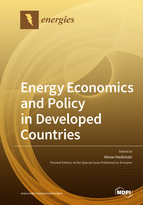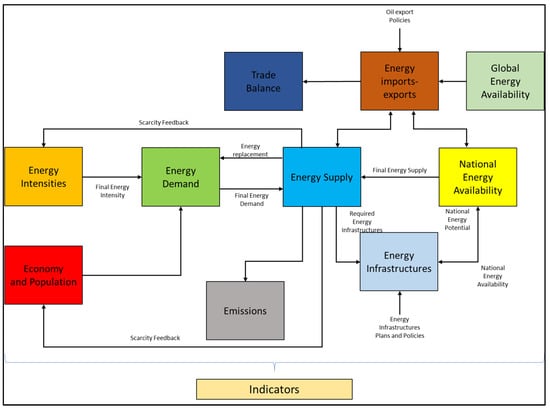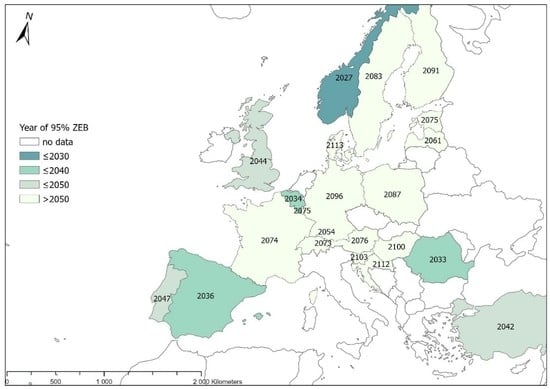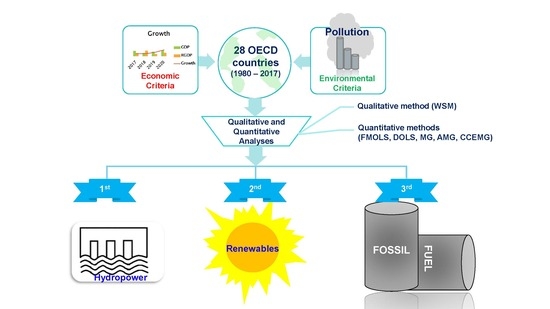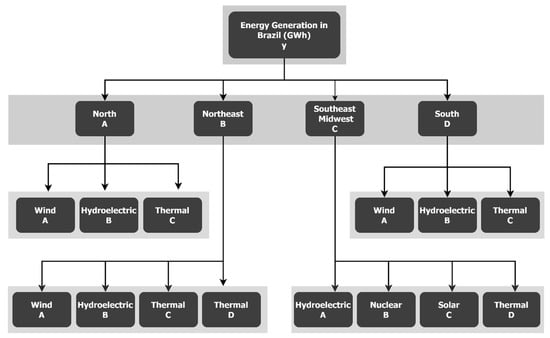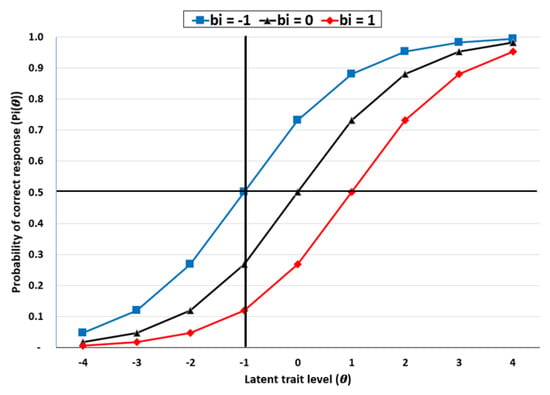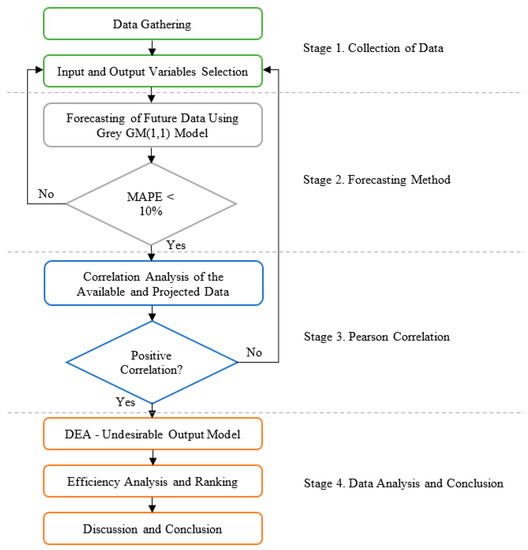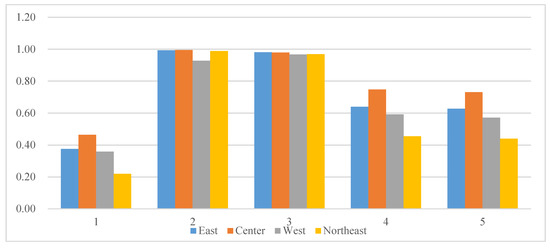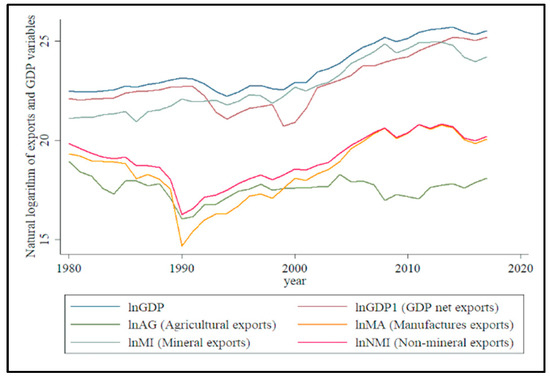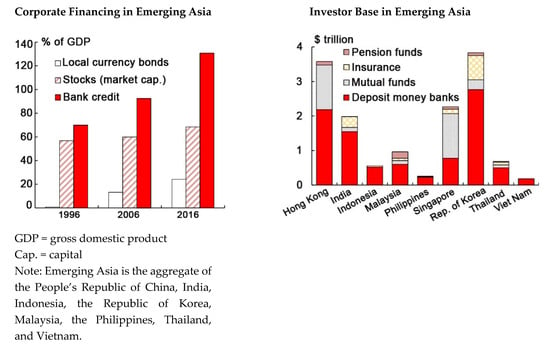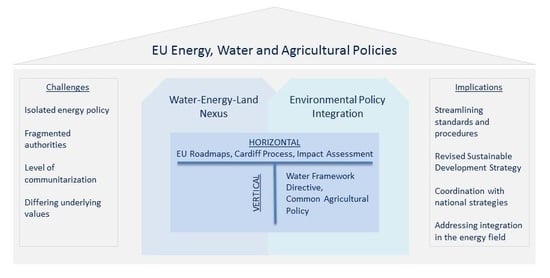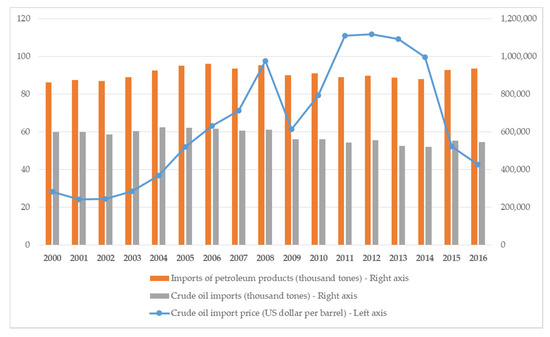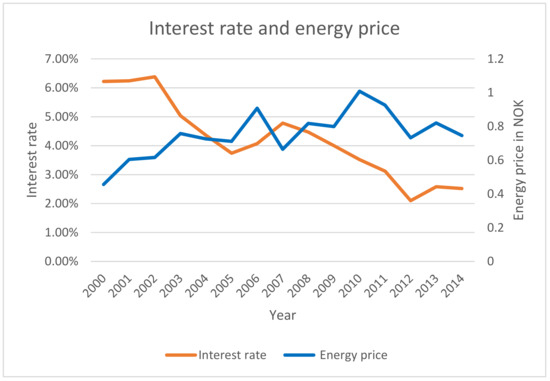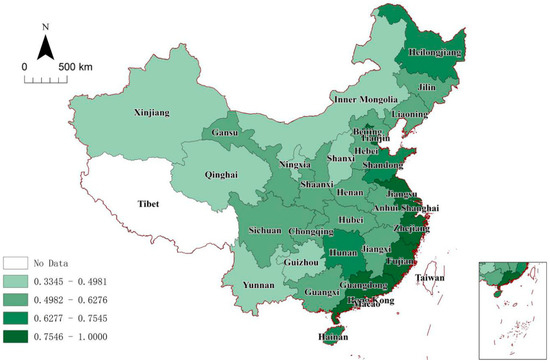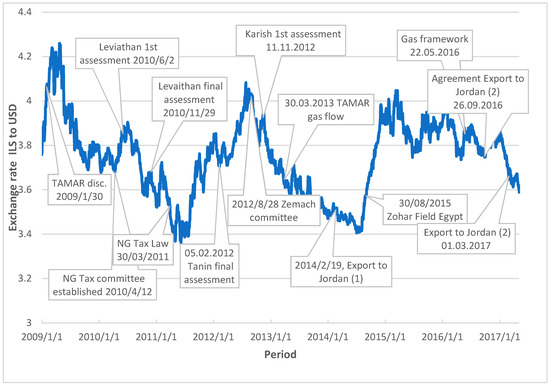Energy Economics and Policy in Developed Countries
Printed Edition Available!
A printed edition of this Special Issue is available
here.
Share This Topical Collection
Editor
 Prof. Dr. Almas Heshmati
Prof. Dr. Almas Heshmati
 Prof. Dr. Almas Heshmati
Prof. Dr. Almas Heshmati
E-Mail
Website
Collection Editor
Jönköping International Business School (JIBS), Jönköping University, Room B5017, P.O. Box 1026, SE-551 11 Jönköping, Sweden
Interests: applied microeconomics; globalization; development strategy; efficiency; productivity and growth with application to manufacturing and services
Special Issues, Collections and Topics in MDPI journals
Topical Collection Information
Dear Colleagues,
Energy use per capita and as share of GDP in developed countries is high. The high rate is attributed to the rapid economic development and welfare that rely heavily on energy-intensive technologies and, in particular, on relatively low-price and easily accessible fossil fuels. Total energy consumption is continuously increasing, and the primary source of electricity generation is increasingly based on renewable and non-fossil fuels. Production and consumption are also increasingly oriented towards the use of more efficient and energy-saving technologies. The global, national, and local environmental degradation and its strong effect on health have promoted the development of institutional capacity, technologies, environmental policies, regulations, and incentive programs to reduce energy use and its negative health and environmental impacts. Efforts are made to change production and consumption patterns through various command-and-control polices, yet their effects are small, and the coordination of costly environmental activities to avert a radical climate change is difficult to achieve. The combined crisis of poverty and environmental degradation is aggravated by an increased gap between north and south and a lack of will and coordination to allocate sufficient investment resources to sustainable development. The world is facing environmental degradation, poverty, inequality, climate change, migration, and frequent natural disasters.
This Topical Collection invites high-quality research papers covering a wide range of topics related to energy policy, economics, and politics in developed countries. The articles are expected to inform on how to encourage the development of sustainable, green economies and facilitate financing, technology development, transfer, and applications to mitigate the climate change.
Prof. Dr. Almas Heshmati
Collection Editor
Manuscript Submission Information
Manuscripts should be submitted online at www.mdpi.com by registering and logging in to this website. Once you are registered, click here to go to the submission form. Manuscripts can be submitted until the deadline. All submissions that pass pre-check are peer-reviewed. Accepted papers will be published continuously in the journal (as soon as accepted) and will be listed together on the collection website. Research articles, review articles as well as short communications are invited. For planned papers, a title and short abstract (about 100 words) can be sent to the Editorial Office for announcement on this website.
Submitted manuscripts should not have been published previously, nor be under consideration for publication elsewhere (except conference proceedings papers). All manuscripts are thoroughly refereed through a single-blind peer-review process. A guide for authors and other relevant information for submission of manuscripts is available on the Instructions for Authors page. Energies is an international peer-reviewed open access semimonthly journal published by MDPI.
Please visit the Instructions for Authors page before submitting a manuscript.
The Article Processing Charge (APC) for publication in this open access journal is 2600 CHF (Swiss Francs).
Submitted papers should be well formatted and use good English. Authors may use MDPI's
English editing service prior to publication or during author revisions.
Keywords
- energy policy
- renewable energy
- sustainable economic development
- green economy
- energy saving
- environmental regulations
- technology-based
- incentive programs
- climate change mitigation
Published Papers (16 papers)
Open AccessReview
Energy Price Decoupling and the Split Market Issue
by
Thomas Weyman-Jones
Viewed by 681
Abstract
Load scheduling and dispatch by merit order on electricity generation networks has used a wholesale market electricity system operator model focused on system marginal pricing, in which the spot price of electricity at any point in time is equal to the system marginal
[...] Read more.
Load scheduling and dispatch by merit order on electricity generation networks has used a wholesale market electricity system operator model focused on system marginal pricing, in which the spot price of electricity at any point in time is equal to the system marginal cost given by the higher value of the price, which rations demand to capacity or the operating cost of the most expensive plant on the system, which is usually a fossil fuel price. This idea has come under challenge because renewable technologies such as wind power farms or solar power farms are treated as having close to zero operating costs. The challenges, under the general heading of energy price decoupling, include suggestions for operating split markets possibly overseen by a regulator, and the prediction that marginal cost pricing should be abandoned. This review evaluates these in terms of their economic impact, relating them to the policy debates on electricity market reform.
Full article
Open AccessFeature PaperArticle
Energy Transition Scenarios for Fossil Fuel Rich Developing Countries under Constraints on Oil Availability: The Case of Ecuador
by
Vicente Sebastian Espinoza, Javier Fontalvo, Paola Ramírez, Jaime Martí-Herrero and Margarita Mediavilla
Cited by 1 | Viewed by 2056
Abstract
The aim of this paper is to analyze energy pathways for a fossil fuel rich developing country towards an energy transition considering national and international oil availability using Ecuador as a reference. An integrated assessment model has been developed to simulate energy transition
[...] Read more.
The aim of this paper is to analyze energy pathways for a fossil fuel rich developing country towards an energy transition considering national and international oil availability using Ecuador as a reference. An integrated assessment model has been developed to simulate energy transition scenarios considering constraints on oil availability at the national and global level. Results show that if current trends in energy demand and supply persist, energy scarcity would start around 2040 due to depletion of national oil reserves and restricted access to foreign oil. This would trigger a degrowth in economic activity in sectors with high dependency on petroleum products. Scenarios with conservative efforts might partially revert the increasing use of fossil fuels supported by policies for energy efficiency and substitution of liquid fuels with electricity mainly from renewables. However, energy shortages would still be foreseeable as well as a decay of the economy. Under a maximum efforts scenario with an optimistic availability of national oil, a moderate-sustained economic growth could be feasible. This shows that oil would still play a key role during the transition. Furthermore, ambitious policies must be implemented in the short term to smooth the effects of displacing oil as energy and income source.
Full article
►▼
Show Figures
Open AccessArticle
Development Forecasts for the Zero-Emission Bus Fleet in Servicing Public Transport in Chosen EU Member Countries
by
Anna Brdulak, Grażyna Chaberek and Jacek Jagodziński
Cited by 31 | Viewed by 7650
Abstract
Nearly two-thirds of the emissions that cause smog come from road transport. In April 2019, the European Parliament adopted new regulations on public procurement to encourage investment in clean buses—electric, hydrogen, or gas. Directive 2009/33/EC is to apply from the second half of
[...] Read more.
Nearly two-thirds of the emissions that cause smog come from road transport. In April 2019, the European Parliament adopted new regulations on public procurement to encourage investment in clean buses—electric, hydrogen, or gas. Directive 2009/33/EC is to apply from the second half of 2021. The aim of this article is to make an attempt to simulate the number of zero-emission buses (ZEB) in European Union (EU) member countries in two time horizons: 2025 and 2030, and to forecast the number of clean vehicles in the precise time horizons, including before and after 2050. Research questions are as follows: (1) what will be the number of ZEBs in individual EU countries over the next few years; (2) which of the EU countries will reach by 2030 the level of 95% share of ZEBs in all buses, which are a fleet of public transport buses; and (3) in which year will which EU countries reach the level of 95% share of zero-emission buses. The method used is a Bass model. The conducted analyses demonstrate that, by 2050, only four of the EU members will be able to reach 95% level of share of clean buses in the city bus transport fleets. It is likely that other countries may not achieve this even by 2050.
Full article
►▼
Show Figures
Open AccessArticle
The Balanced Energy Mix for Achieving Environmental and Economic Goals in the Long Run
by
Anh Hoang To and Duc Hong Vo
Cited by 4 | Viewed by 2250
Abstract
In this paper, we seek to find a balanced structure of energy sources that can simultaneously achieve two essential goals: (i) the environmental (degradation) goal and (ii) the economic (growth) goal. This study combines quantitative and qualitative methods to estimate and then rank
[...] Read more.
In this paper, we seek to find a balanced structure of energy sources that can simultaneously achieve two essential goals: (i) the environmental (degradation) goal and (ii) the economic (growth) goal. This study combines quantitative and qualitative methods to estimate and then rank each of the energy sources (including coal, gas, oil, hydropower, and renewable energy) to achieve the above two goals. This paper uses the weighted scoring method, the most popular method in multi-criteria decision-making techniques, to combine the rankings using five energy sources and two goals from panel data of 28 countries from Organization for Economic Co-operation and Development (OECD) countries for the period 1980–2017. Techniques for estimating the mean group long-run effect, including fully modified ordinary least squares (FMOLS) and dynamic ordinary least squares (DOLS), are used. The empirical findings of this paper reveal that, in the long term, in achieving both environmental goals and economic goals, the OECD countries should consider adopting a balanced energy mix in which the following structure is preferred: (i) hydropower, (ii) renewables and (iii) fossil fuels (oil, gas, coal).
Full article
►▼
Show Figures
Open AccessArticle
Forecasting Hierarchical Time Series in Power Generation
by
Tiago Silveira Gontijo and Marcelo Azevedo Costa
Cited by 7 | Viewed by 6346
Abstract
Academic attention is being paid to the study of hierarchical time series. Especially in the electrical sector, there are several applications in which information can be organized into a hierarchical structure. The present study analyzed hourly power generation in Brazil (2018–2020), grouped according
[...] Read more.
Academic attention is being paid to the study of hierarchical time series. Especially in the electrical sector, there are several applications in which information can be organized into a hierarchical structure. The present study analyzed hourly power generation in Brazil (2018–2020), grouped according to each of the electrical subsystems and their respective sources of generating energy. The objective was to calculate the accuracy of the main measures of aggregating and disaggregating the forecasts of the Autoregressive Integrated Moving Average (ARIMA) and Error, Trend, Seasonal (ETS) models. Specifically, the following hierarchical approaches were analyzed: (i) bottom-up (BU), (ii) top-down (TD), and (iii) optimal reconciliation. The optimal reconciliation models showed the best mean performance, considering the primary predictive windows. It was also found that energy forecasts in the South subsystem presented greater inaccuracy compared to the others, which signals the need for individualized models for this subsystem.
Full article
►▼
Show Figures
Open AccessArticle
Application of IRT Models to Selection of Bidding Paths in Financial Transmission Rights Auction: U.S. New England
by
Peter Y. Jang, Kwanghee Jung and Mario G. Beruvides
Cited by 1 | Viewed by 2092
Abstract
This paper explores a way to apply Item Response Theory (IRT), one of the popular statistical methodologies in measurement and psychometrics, to evaluate Financial Transmission Rights (FTR) paths in the U.S. electricity market. FTR is an energy derivative product to hedge congestion cost
[...] Read more.
This paper explores a way to apply Item Response Theory (IRT), one of the popular statistical methodologies in measurement and psychometrics, to evaluate Financial Transmission Rights (FTR) paths in the U.S. electricity market. FTR is an energy derivative product to hedge congestion cost risks inherent in constrained transmission lines. In New England, with about 1200 pricing locations, the theoretical combinations of FTR paths amount to 1.4 million in prevailing flows alone. With capital constraints, it is imperative that FTR market participants build the capability to evaluate FTR paths to bid on. IRT provides a framework of how well tests work, and how individual items work on tests, estimating respondents’ latent abilities, and individual item parameters. IRT is utilized to analyze historical electricity data of 2019 for a daily congestion cost of eight customer load zones and one hub in the U.S., New England, for the evaluation of FTR paths. In the analysis, an item represents an FTR path, while item difficulty, item discrimination, and a latent trait variable for the path correspond to the path profitability, risk level, and daily congestion ability, respectively. This paper explores the experimental procedures by which IRT, a psychometric tool, may also be applicable in complex energy markets, providing a consistent and standardized analytical framework to address the issues of selection and prioritization among multiple opportunities. FTR path evaluation is conducted in three steps to determine bid priority paths in FTR auctions: parameter significance tests, ranking on path profitability and risk level, and weighting scores of individual rankings on the two criteria.
Full article
►▼
Show Figures
Open AccessArticle
Renewable Energy Utilization Analysis of Highly and Newly Industrialized Countries Using an Undesirable Output Model
by
Chia-Nan Wang, Hector Tibo and Duy Hung Duong
Cited by 15 | Viewed by 2987
Abstract
In the fight against climate change, the utilization of renewable energy resources is being encouraged in every country all over the world to lessen the emissions of greenhouse gases. However, not all countries are able to efficiently utilize these resources, and instead of
[...] Read more.
In the fight against climate change, the utilization of renewable energy resources is being encouraged in every country all over the world to lessen the emissions of greenhouse gases. However, not all countries are able to efficiently utilize these resources, and instead of providing solutions, the inefficient use of renewable energy may lead to even more damage to the environment. Data from eight countries belonging to the highly industrialized countries (HIC) group and nine from newly industrialized countries (NIC) group were used to evaluate the energy utilization of these groups. Factors such as total renewable energy capacity, the labor force, and total energy consumption were considered to be the input factors, while, CO
2 emission and gross domestic product are the output factors. These factors were used to calculate efficiency scores of every country from 2013 to 2018 using the undesirable output model of Data envelopment analysis (DEA). The grey prediction model was also used to measure the forecasted values of the input and output factors for the year 2019 to 2022, and measure again the future efficiency scores of the HICs and NICs. The combination of grey prediction and DEA undesirable output model made this paper unusual and the most appropriate method in dealing with data that contains both desired and undesired outputs. The results show that the United Kingdom, Germany, France, and the United States continuously top the efficiency ranking among the HIC group, with a perfect 1.0 efficiency score from 2013 to 2022. Russia demonstrates the lowest score of 0.1801 and is expected to perform the same low-efficiency score in the future. Within the NIC group, Indonesia can be highlighted for performing with perfect efficiency starting from the year 2015 and even through 2022. Other NICs are performing at a very low-efficiency, with scores ranging from 0.2278 to 0.2734 on average, with Turkey displaying the lowest rank. This study recommends some useful strategies to improve the utilization of renewable energy resources such as improvements in the political and legal structure surrounding their use and regulation, tax incentives or exemptions to private power producers to encourage shifting away from conventional energy production, partnerships with non-governmental and international organizations that can provide assistance in managing renewable energies, strengthening of the energy sector’s research and development activities and long-term strategic plans for the development in renewable energy with considerations to the social, environmental, and economic impact on each country.
Full article
►▼
Show Figures
Open AccessArticle
An Analysis of Energy Use Efficiency in China by Applying Stochastic Frontier Panel Data Models
by
Xiaoyan Zheng and Almas Heshmati
Cited by 6 | Viewed by 2127
Abstract
This paper investigates energy use efficiency at the province level in China using the stochastic frontier panel data model approach. The stochastic frontier model is a parametric model which allows for the modeling of the relationship between energy use and its determinants using
[...] Read more.
This paper investigates energy use efficiency at the province level in China using the stochastic frontier panel data model approach. The stochastic frontier model is a parametric model which allows for the modeling of the relationship between energy use and its determinants using different control variables. The main control variables in this paper are energy policy and environmental and regulatory variables. This paper uses province level data from all provinces in China for the period 2010–2017. Three different models are estimated accounting for the panel nature of the data; province-specific heterogeneity and province-specific energy inefficiency effects are separated. The models differ because of their underlying assumptions, but they also complement each other. The paper also explains the degree of inefficiency in energy use by its possible determinants, including those related to the public energy policy and environmental regulations. This research supplements existing research from the perspective of energy policy and regional heterogeneity. The paper identifies potential areas for improving energy efficiency in the western and northeastern regions of China. Its findings provide new empirical evidence for estimating and evaluating China’s energy efficiency and a transition to cleaner energy sources and production.
Full article
►▼
Show Figures
Open AccessArticle
Effects of Agricultural, Manufacturing, and Mineral Exports on Angola’s Economic Growth
by
Titus Isaiah Zayone, Shida Rastegari Henneberry and Riza Radmehr
Cited by 12 | Viewed by 3997
Abstract
This study investigates the effects of Angola’s agricultural, manufacturing, and mineral exports on the country’s economic growth using data from 1980 to 2017. An Autoregressive Distributed Lag (ARDL) model is employed to estimate the effect of sectoral exports on economic growth. The estimation
[...] Read more.
This study investigates the effects of Angola’s agricultural, manufacturing, and mineral exports on the country’s economic growth using data from 1980 to 2017. An Autoregressive Distributed Lag (ARDL) model is employed to estimate the effect of sectoral exports on economic growth. The estimation results show that while exports from all three sectors (manufacturing, mineral, and non-mineral) have driven Angola’s economic growth in the long-run; only non-manufacturing (agricultural and mineral) exports have led its growth in the short-run. Moreover, growth in non-export GDP was driven by mineral exports in the long-run and agricultural exports in the short-run. Considering the statistically significant and positive impact of mineral exports on the Angolan GDP as well as on its non-export GDP, this study points to a lack of evidence supporting the Dutch disease phenomenon in Angola.
Full article
►▼
Show Figures
Open AccessArticle
Sustainable Solutions for Green Financing and Investment in Renewable Energy Projects
by
Farhad Taghizadeh-Hesary and Naoyuki Yoshino
Cited by 253 | Viewed by 21527
Abstract
The lack of long-term financing, the low rate of return, the existence of various risks, and the lack of capacity of market players are major challenges for the development of green energy projects. This paper aimed to highlight the challenges of green financing
[...] Read more.
The lack of long-term financing, the low rate of return, the existence of various risks, and the lack of capacity of market players are major challenges for the development of green energy projects. This paper aimed to highlight the challenges of green financing and investment in renewable energy projects and to provide practical solutions for filling the green financing gap. Practical solutions include increasing the role of public financial institutions and non-banking financial institutions (pension funds and insurance companies) in long-term green investments, utilizing the spillover tax to increase the rate of return of green projects, developing green credit guarantee schemes to reduce the credit risk, establishing community-based trust funds, and addressing green investment risks via financial and policy de-risking. The paper also provides a practical example of the implementation of the proposed tools.
Full article
►▼
Show Figures
Open AccessArticle
Linking Environmental Policy Integration and the Water-Energy-Land-(Food-)Nexus: A Review of the European Union’s Energy, Water, and Agricultural Policies
by
Sandra Venghaus, Carolin Märker, Sophia Dieken and Florian Siekmann
Cited by 29 | Viewed by 3561
Abstract
Against the backdrop of climate and environmental pressures, as well as limited resource availability and trade conflicts, devising policies for energy and the use of natural resources in general becomes exceedingly complex. Moreover, policies are required to account for interrelations between individual resources
[...] Read more.
Against the backdrop of climate and environmental pressures, as well as limited resource availability and trade conflicts, devising policies for energy and the use of natural resources in general becomes exceedingly complex. Moreover, policies are required to account for interrelations between individual resources and between different sectors and policy fields, but implementation often lacks. To evaluate the current state of integrated policy design in the EU, a review of European energy, water, and agricultural policies was conducted. Using a qualitative comparative research approach, the objective was to identify and explain the differing degrees and variations in policy integration among them. To this aim, the concepts “Environmental Policy Integration” and “Water-Energy-Land Nexus” were jointly applied as analytical frameworks. The analysis revealed that currently, different authorities are endowed with largely sectoral mandates. Accordingly, the respective sectoral policy sets are historically grown based on differing sets of formal and informal rules and processes, thus making policy integration among the sectors, let alone within the nexus, a highly challenging task.
Full article
►▼
Show Figures
Open AccessArticle
Oil Price and Stock Prices of EU Financial Companies: Evidence from Panel Data Modeling
by
Alexandra Horobet, Georgiana Vrinceanu, Consuela Popescu and Lucian Belascu
Cited by 9 | Viewed by 3543
Abstract
Crude oil is an indispensable resource for the world economy and European Union (EU) countries are strongly dependent on oil imports. In a framework defined by generally positive correlations between oil and stock prices, the paper investigates the relationship between financial companies’ stock
[...] Read more.
Crude oil is an indispensable resource for the world economy and European Union (EU) countries are strongly dependent on oil imports. In a framework defined by generally positive correlations between oil and stock prices, the paper investigates the relationship between financial companies’ stock prices and crude oil price using a sample of major financial companies headquartered in the EU. The link between stock prices and oil price risk is modelled using a set of macroeconomic variables that includes local stock market indices, the EUR/USD exchange rate, the oil imports dependency, inflation rate, and global volatility indices. We employ panel data as the base econometric model and an ARDL extension that is more appropriated for our research objectives. Our findings show that the EU financial sector is pervasively exposed to oil price changes over the long-run and this exposure is a component of financial companies’ exposure to real economy risk factors, which points towards the key role of the financial sector in the EU economy in transmitting systemic shocks. At the same time, we detect signs of a different behavior of market investors over the short-versus the long-run concerning the valuation of financial companies’ stock prices in relation to oil price and other macroeconomic variables, which raises distressing challenges for financial authorities.
Full article
►▼
Show Figures
Open AccessArticle
Energy Performance Certificates—The Role of the Energy Price
by
Jon Olaf Olaussen, Are Oust, Jan Tore Solstad and Lena Kristiansen
Cited by 17 | Viewed by 4104
Abstract
Energy performance certificates (EPCs) were introduced to give property buyers better information about the energy efficiency of dwellings and provide incentives to make energy-efficient investments. Previous studies on the effect of EPCs on property value have yielded divergent results, with some studies finding
[...] Read more.
Energy performance certificates (EPCs) were introduced to give property buyers better information about the energy efficiency of dwellings and provide incentives to make energy-efficient investments. Previous studies on the effect of EPCs on property value have yielded divergent results, with some studies finding that energy labels affect property values, but others finding that energy labels have little or no effect. The present paper takes the analysis one step further. Using data on energy prices in combination with transaction data from Oslo, we conclude that not only the energy label, but also the energy performance of dwellings in general, has little to no effect on transaction prices. This result is in line with the inferences of several survey studies, which indicate that when people buy a dwelling, they pay considerably less attention to its energy performance compared with other factors, such as the location, neighborhood, size, garden, and the number of bedrooms.
Full article
►▼
Show Figures
Open AccessArticle
Analysis of Regional Differences and Influencing Factors on China’s Carbon Emission Efficiency in 2005–2015
by
Liangen Zeng, Haiyan Lu, Yenping Liu, Yang Zhou and Haoyu Hu
Cited by 69 | Viewed by 4680
Abstract
With the challenge to reach targets of carbon emission reduction at the regional level, it is necessary to analyze the regional differences and influencing factors on China’s carbon emission efficiency. Based on statistics from 2005 to 2015, carbon emission efficiency and the differences
[...] Read more.
With the challenge to reach targets of carbon emission reduction at the regional level, it is necessary to analyze the regional differences and influencing factors on China’s carbon emission efficiency. Based on statistics from 2005 to 2015, carbon emission efficiency and the differences in 30 provinces of China were rated by the Modified Undesirable Epsilon-based measure (EBM) Data Envelopment Analysis (DEA) Model. Additionally, we further analyzed the influencing factors of carbon emission efficiency’s differences in the Tobit model. We found that the overall carbon emission efficiency was relatively low in China. The level of carbon emission efficiency is the highest in the East region, followed by the Central and West regions. As for the influencing factors, industrial structure, external development, and science and technology level had a significant positive relationship with carbon emission efficiency, whereas government intervention and energy intensity demonstrated a negative correlation with carbon emission efficiency. The contributions of this paper include two aspects. First, we used the Modified Undesirable EBM DEA Model, which is more accurate than traditional methods. Secondly, based on the data’s unit root testing and cointegration, the paper verified the influencing factors of carbon emission efficiency by the Tobit model, which avoids the spurious regression. Based on the results, we also provide several policy implications for policymakers to improve carbon emission efficiency in different regions.
Full article
►▼
Show Figures
Open AccessArticle
The Symptoms of Illness: Does Israel Suffer from “Dutch Disease”?
by
Ruslana Rachel Palatnik, Tchai Tavor and Liran Voldman
Cited by 10 | Viewed by 3790
Abstract
The natural gas revolution in Israel started about two decades ago. Its numerous social impacts include moving to cleaner energy, improving energy security and the balance of trade, tightening international relations, and increasing tax revenue. However, “Dutch disease” phenomena—where the accelerated export of
[...] Read more.
The natural gas revolution in Israel started about two decades ago. Its numerous social impacts include moving to cleaner energy, improving energy security and the balance of trade, tightening international relations, and increasing tax revenue. However, “Dutch disease” phenomena—where the accelerated export of natural gas leads to the strengthening of the local currency, the subsequent weakening of other exporting industries, and rising unemployment—might suck Israel into the economic slowdown. This study examines whether the strengthening of the New Israeli Shekel (ILS) in recent years is a symptom of “Dutch disease”. It is expected that the large-scale export of natural gas will start in 2021 with the development of the major offshore field “Leviathan”. Notably, ILS has been appreciating for several years already. We employed the event study approach to analyze the fluctuations of the daily ILS/USD real exchange rate in the years 2009–2017, combined with the media announcements related to the gas discoveries published during this period. The results revealed that gas-related news does affect the exchange rate and appreciate ILS. GARCH analysis confirms the results.
Full article
►▼
Show Figures
Open AccessArticle
The Effects of Environmental Regulations on the Manufacturing Industry’s Performance: A Comparison of Green and Non-Green Sectors in Korea
by
Seulgi Yoo and Almas Heshmati
Cited by 8 | Viewed by 3178
Abstract
This study examines the effects of strengthened environmental regulations on employment and labor productivity in the Korean manufacturing industry using panel data from 2004 to 2015. It divides the industry into environmental (green and non-green) and carbon dioxide emitting (polluting and non-polluting) sectors
[...] Read more.
This study examines the effects of strengthened environmental regulations on employment and labor productivity in the Korean manufacturing industry using panel data from 2004 to 2015. It divides the industry into environmental (green and non-green) and carbon dioxide emitting (polluting and non-polluting) sectors to investigate the industrial sector’s response heterogeneity to tightened regulations. We draw several conclusions on the basis of our empirical results. Firstly, environmental policies measured by enacting the LCGG (Low-carbon green growth) Act led to negative effects on labor productivity and employment in polluting industries. These negative effects show that the polluting industries take a higher cost burden because of the environmental policies as compared to the less-polluting industries; this finding is in line with previous studies in literature. Secondly, the green sector is experiencing higher labor productivity and employment as compared to the non-green sector after the tightened environmental regulations. Thirdly, the regulation-related negative effects anticipated in polluting industries are off-set if a firm is also included in the green sector which produces environment-related products. Hence, this result suggests that in terms of labor productivity and employment, it is possible that the manufacturing industry enables the achievement of sustainable development targets. While regulations negatively affect the performance of non-green firms by increasing the costs of highly contaminated ones, in the case of the green sector the regulations promote labor productivity and employment. This shows that a firm in the green sector which has high carbon dioxide emissions can adapt faster than its counterparts in a non-environmental sector in the polluting industry to the constraints imposed by strengthened environmental regulations. These empirical results imply that there will be labor reallocation from non-green to green sectors.
Full article
►▼
Show Figures
Planned Papers
The below list represents only planned manuscripts. Some of these
manuscripts have not been received by the Editorial Office yet. Papers
submitted to MDPI journals are subject to peer-review.
Type: Article
Title: The Paradoxes and Prospects for Contemporary Australian Electricity Provisioning and Future Energy Security
Author: Lynne Chester
Affiliation: The University of Sydney, Department of Political Economy; lynne.chester@sydney.edu.au
Abstract: Electricity sectors around the world have been radically transformed over the past 30 years or so. The Australian electricity sector, the cornerstone of the nation’s energy policy, was acclaimed by the International Energy Agency as a role model with the virtual adoption—since the mid-1990s—of Joskow’s (2006) textbook restructuring model. This article examines the outcomes of the Australian electricity sector’s restructuring against the proclaimed objectives. A number of paradoxes are found such as energy unaffordability, market concentration, wholesale price volatility driven by market participant gaming behaviour, a centralised grid embedded around aged fossil fuel generation plants, and a rapid uptake of renewable energy sources for electricity generation. These paradoxes, it is concluded, have been driven by policy inconsistencies and conflicts, and pose significant challenges to the future provisioning of Australian electricity and thus the nation’s energy security.
Keywords: Australia; electricity; energy affordability; energy policy; energy security; fossil fuels; market mechanisms; regulation; renewable energy
Title: Development forecasts for the zero-emission bus fleet in servicing public transport in chosen EU Member Countries
Authors: Anna Brdulak 1, Grażyna Chaberek 2*, Jacek Jagodziński 3
Affiliation: 1 Wrocław University of Science and Technology, Faculty of Computer Science and Management; anna.brdulak@pwr.edu.pl 2 University of Gdańsk, Faculty of Oceanography and Geography; grazyna.chaberek@ug.edu.pl 3 Wrocław University of Science and Technology, Faculty of Electronics; jacek.jagodzinski@pwr.edu.pl * Correspondence: grazyna.chaberek@ug.edu.pl
Abstract: Nearly two-thirds of the emissions that cause smog come from road transport. In April 2019, the European Parliament adopted new regulations on public procurement to encourage investment in clean buses - electric, hydrogen or gas. Directive 2009/33 / EC is to apply from the second half of 2021. The aim of the article is to present how the clean buses in city transport phenomenon is increasing in EU countries. Research questions posed against the background of the goal formulated in such a way are as follows: what will be the number of electric buses in individual EU countries over the next few years, which of the EU countries will reach by 2030 the level of 95% share of e-buses in all buses, which are a fleet of public transport buses and in which year which EU countries reach the level of 95% share of e-buses in all buses, which are a fleet of public transport buses. The method used is a simulation model. The conducted analyses demonstrate that by 2077 the most of the EU members will be able to reach 95% level of share of clean buses in the city bus transport fleets. Keywords: Electric buses; e-buses, EU policy, zero emission policy; green energy, city management; simulation model; strategy; sustainable development




